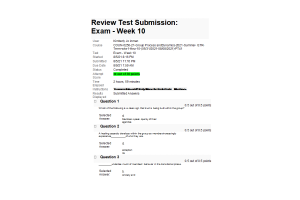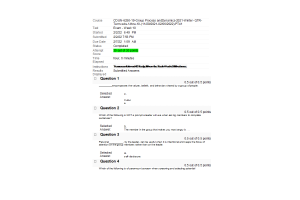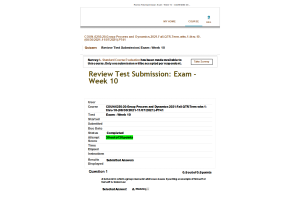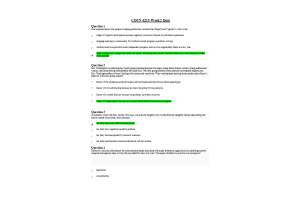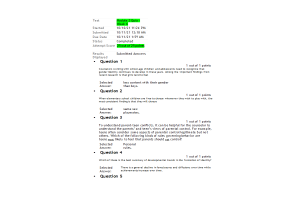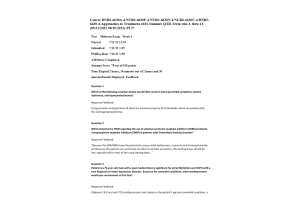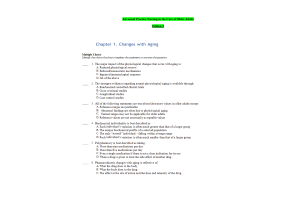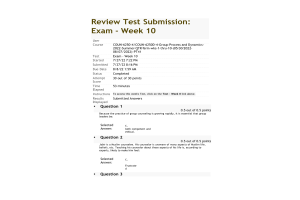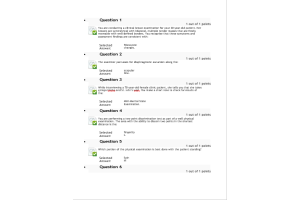COUN 6722-42, Theories of Counseling; Week 10 Final Exam (50 out of 50 Points)
- $45.00
1. Question: Unearned access to resources that is readily available to members of agent groups is known as:
2. Question: All of the following are goals of feminist therapy, except for:
3. Question: Art therapy, dance/movement therapy, music therapy, and drama therapy are all considered:
4. Question: According to Albert Ellis, “shoulds,” “oughts,” and “musts” fall under which of the following categories?
5. Question: Adlerians believe that discouragement:
6. Question: The family life spiral is:
7. Question: One strategy for empowering clients is to involve them in naming their problem and participating in directing the counseling process. This strategy is called:
8. Question: Reality therapy can be applied to the following clients:
9. Question: An important step in becoming a culturally competent counselor or group worker is gaining awareness of one’s own cultural influences.
10. Question: Which of the following is not considered one of the six core principles of feminist therapy?
11. Question: In the A-B-C model proposed by Albert Ellis, the factor that creates the emotional and behavioral consequences is the:
12. Question: Which one of the following is not associated with the cognitive-behavioral action- oriented therapies?
13. Question: Action therapy is considered a form of:
14. Question: Which of these solution-focused therapy techniques ... solve their problem or when their problem was less severe?
15. Question: The founders of solution-focused brief therapy are:
16. Question: The concept of triangulation is most associated with:
17. Question: Which of the following is not consistent with rational emotive behavior therapy?
18. Question: The founder of rational emotive behavioral therapy (REBT) is:
19. Question: The developer of dialectical behavior therapy is:
20. Question: The counseling profession has fully adapted to the diversity of society.
21. Question: The systems perspective implies:
22. Question: When using extinction to change behavior:
23. Question: he cornerstone of the practice of reality therapy is self-evaluation by the client aided by the counselor or therapist.
24. Question: In reality therapy, the skilled counselor or therapist treats behavior as:
25. Question: The Association for Multicultural Counseling and Development’s Multicultural Counseling Competencies emphasize:
26. Question: Rational emotive behavior therapy ... irrationally as well as rationally.
27. Question: All of the following are techniques used in solution-focused therapy, except for:
28. Question: Which of the following family therapists is best known for his or her structural approach to treatment:
29. Question: William Glasser would agree with all of the following except:
30. Question: An ethnic minority client is silent during the initial phase of counseling. This silence is probably best interpreted as:
31. Question: One of the primary goals of transpersonal counseling is to:
32. Question: Although the theoretical underpinnings of transpersonal theory can be credited to a number of individuals, theories, and philosophical approaches to mental health and spiritual experience, has emerged as the primary leader of this burgeoning field.
33. Question: The core practice of transpersonal counseling includes which of the following:
34. Question: Regarding multicultural counseling, narrative therapy has been found to be particularly effective because:
35. Question: Teasing out stressors poses a challenge for the family therapist because of the family’s:
36. Question: A change agent is:
37. Question: Feminist counselors believe it is essential to recognize ... expectations begin to influence human development from the moment a child is born.
38. Question: The central issue in existential therapy is:
39. Question: As a person becomes more congruent, which of the following changes is most likely to be seen?
40. Question: A family system’s perspective implies:
41. Question: The term minority or marginalized refers to:
42. Question: Cognitive-behavioral theories involve cognitive restructuring, coping skills, and problem solving.
43. Question: The central concept of the expressive arts approach in counseling is:
44. Question: Counselor competency with integrative ... of integrative approaches in counseling and psychotherapy.
45. Question: In choice theory, human motivation springs from which of these five sources?
46. Question: In practicing reality therapy, counselors and therapists focus on:
47. Question: Which of the following are true regarding advocacy as a part of counseling and psychotherapy?
48. Question: A client is partaking in cognitive distortion when he or ... impact than it deserves. What is this called?
49. Question: Understanding the nature of the presenting problem in the goals of cognitive- behavioral theory is best looked at through which perspective?
50. Question: Two major disorders given a great deal of attention in feminist literature are:
-600x800.png)
